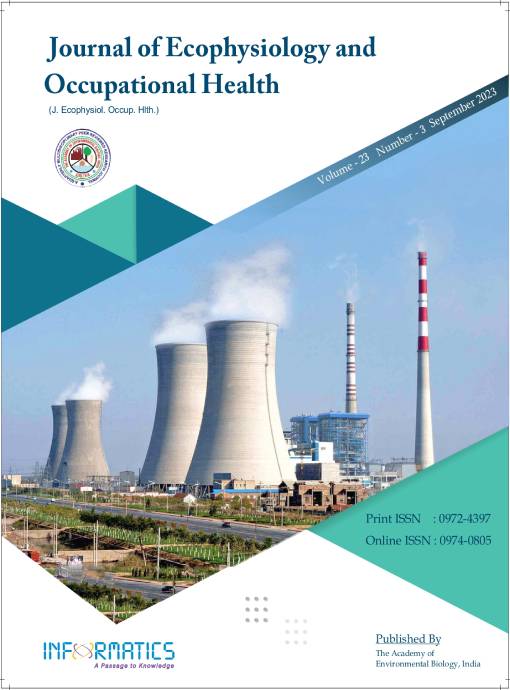Role and Effect of Migrant Workers on Economic Rationalization and the Unorganized Sector in Kerala
DOI:
https://doi.org/10.18311/jeoh/2023/34105Keywords:
Contract Employees, Migration, Migrant WorkersAbstract
Recently, there has been a significant arrival of migrant labourers from various parts of India to Kerala, attracted by higher wages, abundant job opportunities, and a shortage of local workers. This study aims to explore the impact of migrant workers on Kerala’s economy and labour market, examining their professional and personal benefits. Employing a descriptive research approach, the study heavily relies on secondary sources from print and digital media, including books, journals, newspapers, articles, and government databases. It analyzes the effect of migration on economic rationalization and assesses the economic and social advantages brought about by migration. Parameters such as the number of migrant employees, labour force participation rate, worker-population ratio, and wage rates are investigated. The study anticipates a substantial increase in migrant workers in the Kerala economy, from 650,000 in 2011 to 31,500,000 in 2020. It also reveals improvements in earnings and employment prospects, particularly in the construction industry (60%), manufacturing sector (8%), lodging and food services (7%), commerce (2%), and agriculture (2%). Migration enhances living conditions, enriches social lives, and promotes intergroup harmony through exposure to diverse cultures, traditions, and languages.
Downloads
Metrics
Downloads
Published
How to Cite
Issue
Section
License
Copyright (c) 2023 Nitin Kumar Nair, Jijo K. Cherian, Kamal, S. Suresha, V. Ramalakshmi

This work is licensed under a Creative Commons Attribution 4.0 International License.
Accepted 2023-08-22
Published 2023-09-19
References
Sawyer SW, Stewart I. Introduction: New perspectives on France’s “liberal moment.” In Search of the Liberal Moment (pp. 1-16). New York: Palgrave Macmillan; 2016. https://doi. org/10.1057/9781137581266_1 PMid:25633608 DOI: https://doi.org/10.1057/9781137581266_1
Carter CF, Williams BR. Industry and technical progress: Factors governing the speed of application of science. Oxford University Press; 1957.
Ayuwat D, Chamaratana T. The role of labour broker networks in setting the price of working abroad for Thai migrant workers. Asia-Pacific Population Journal. 2014; 28(2):51-68. https:// doi.org/10.18356/b5c04140-en DOI: https://doi.org/10.18356/b5c04140-en
Hugo G. International labour migration and migration policies in Southeast Asia. Asian Journal of Social Science. 2012; 40(4):392- 418. https://doi.org/10.1163/15685314-12341250 DOI: https://doi.org/10.1163/15685314-12341250
Zafar MI, Siddique S, Zafar MU, Asim M, Batool Z. Migration behaviour within socio-cultural and demographic context: A case study of Faisalabad City, Pakistan. Academic Journal of Interdisciplinary Studies. 2013; 2(2):29. https://doi.org/10.5901/ ajis.2013.v2n2p29
Bhagat RB. Changing pattern of internal migration in India. In Contemporary demographic transformations in China, India, and Indonesia. Springer, Cham. 2016; 239-54. https://doi. org/10.1007/978-3-319-24783-0_15 DOI: https://doi.org/10.1007/978-3-319-24783-0_15
King R, Mata-Codesal D, Vullnetari J. Migration, development, gender and the ‘black box’ of remittances: Comparative findings from Albania and Ecuador. Comparative Migration Studies. 2013; 1(1):69-96. https://doi.org/10.5117/CMS2013.1.KING DOI: https://doi.org/10.5117/CMS2013.1.KING
Rajan SI, Joseph J. Migration (In) flux: Impact of legislation on patterns and quantum of irregular mobility between India and Saudi Arabia. Skillful survivals: Irregular migration to the Gulf, 269; 2017.
Dutta PV. Accounting for wage inequality in India. Indian Journal of Labour Economics. 2005; 48(2):273-95.
Hujo K. Linking social policy, migration, and development in a regional context: The case of sub-Saharan Africa. Regions and Cohesion. 2013; 3(3):30-55. https://doi.org/10.3167/ reco.2013.030303 DOI: https://doi.org/10.3167/reco.2013.030303
Peter B, Sanghvi S, Narendran V. Inclusion of interstate migrant workers in Kerala and lessons for India. The Indian Journal of Labour Economics. 2020; 63(4):1065-86. https://doi.org/10.1007/ s41027-020-00292-9 PMid:33204053 PMCid: PMC7659401 DOI: https://doi.org/10.1007/s41027-020-00292-9
Lall SV, Selod H. Rural-urban migration in developing countries: A survey of theoretical predictions and empirical findings. World Bank Publications. 2006; 3915. https://doi.org/10.1596/1813- 9450-3915 DOI: https://doi.org/10.1596/1813-9450-3915
Watanabe M. Economic development and international labour migration in Malaysia. International Migration in APEC Member Economies: Its Relations with Trade, Investment, and Economic Development, APEC Study Center publications; 2003.
Meng X. Rural-urban migration in China (pp. 382-387). Oxford: Oxford University Press; 2014. https://doi.org/10.1093/acprof: oso/9780199678204.003.0063 DOI: https://doi.org/10.1093/acprof:oso/9780199678204.003.0063
Kerala State Planning Board. Kerala economic review 2001. Government of Kerala; 2001. Available from: https://spb.kerala. gov.in/sites/default/files/inline-files/2001.pdf
Kerala State Planning Board. Kerala Economic Review 2011. Government of Kerala; 2011. Available from: https://spb.kerala. gov.in/economic-review/ER2011//pdf/Chapter05.pdf
Kerala State Planning Board. Kerala Economic Review 2012. Government of Kerala; 2012. https://spb.kerala.gov.in/economicreview/ ER2012//Chapter3/chapter03.html
Kerala State Planning Board. Kerala Economic Review 2015. Government of Kerala; 2015. Available from: https://spb.kerala. gov.in/economic-review/ER2015/Chapter3/chapter03.html
Baiju KC, Shamna T.C. Determinants of wage differences between the immigrant and local labourers in the construction sector of Kerala. Economic and Political Weekly. 2019; 54(31):35.
Deepika VS, Savadatti PM. Reasons for extensive in-migration in Kerala: A study from the employers’ perspective. Indian Journal of Economics and Development. 2018; 6(2).
Subaiya L, Bansod DW. Demographics of population aging in India. Population Ageing in India; 2014; 1. https://doi. org/10.1017/CBO9781139683456.003 DOI: https://doi.org/10.1017/CBO9781139683456.003
Kerala State Planning Board. Kerala Economic Review 2016. Government of Kerala; 2016. Available from: https://spb.kerala. gov.in/economic-review/ER2016/chapter03.php
Kerala State Planning Board. Kerala Economic Review 2017. Government of Kerala; 2017. Available from: https:// spb.kerala.gov.in/economic-review/ER2017/web_e/ch11. php?Id=1&ch=11
Kerala State Planning Board. Kerala Economic Review 2018. Government of Kerala; 2018. https://spb.kerala.gov.in/economicreview/ ER2018/index.php
Kerala State Planning Board. Kerala Economic Review 2019. Government of Kerala; 2019. https://spb.kerala.gov.in/economicreview/ ER2019/index.php
Kerala State Planning Board. Kerala Economic Review 2021. Government of Kerala. 2021. https://spb.kerala.gov.in/sites/ default/files/2021-01/English-Vol-1_0.pdf
Peretto PF, Valente S. Resources, innovation, and growth in the global economy. Journal of Monetary Economics. 2011; 58(4):387-99. https://doi.org/10.1016/j.jmoneco.2011.07.001 DOI: https://doi.org/10.1016/j.jmoneco.2011.07.001
Pathak VK, Soti P, Singh P, Surendran PD. Empirical investigation of influencers of employee turnover from Indian perspective, part I. Test Engineering and Management. 2020; 82(1-2):1358-70.
 Nitin Kumar Nair
Nitin Kumar Nair








